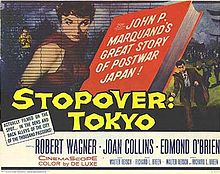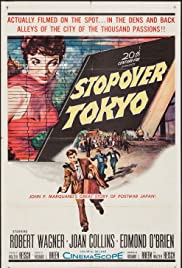Stopover Tokyo *** (1957, Robert Wagner, Joan Collins, Edmond O’Brien) – Classic Movie Review 10,812
After two box-office disappointments, it seemed that Robert Wagner was unable to make the transition to top-level star. This appeared confirmed when he was the lead in Stopover Tokyo (1957), a CinemaScope and DeLuxe colour film noir mystery crime drama from Twentieth Century Fox, filmed in Japan. Despite Wagner and co-star Joan Collins promoting the film with a US nationwide publicity tour, it was not very successful at the box office.
In 1959, Wagner disparaged the film, calling it ‘a dog’: ‘When I started at Fox in 1950 they were making 65 pictures a year. Now they’re lucky if they make 30. There was a chance to get some training in B pictures. Then TV struck. Everything went big and they started sticking me into CinemaScope spectacles. One day, smiling Joe Juvenile with no talent was doing a role intended for John Wayne. That was in a dog called Stopover Tokyo. I’ve really had to work to keep up.’
Nevertheless, director Richard L Breen’s intriguing 1957 espionage tale Stopover Tokyo gave Fox’s contract artists a useful chance to show their paces and the production a well-seized opportunity to film on authentic Japanese backdrops, with fine location photography. Cinematographer Charles G Clarke makes extensive use of location shooting in Kyoto, a sacred Shinto city only lightly bombed in World War Two and taken off the nuclear bombing target list after Henry Stimson argued for the preservation of its cultural assets.
Robert Wagner is solid as the US counter-intelligence agent Mark Fannon, sent to Tokyo on a routine courier mission but soon assigned to protect the American High Commissioner (Larry Keating), America’s ambassador to Japan, who declines to accept the idea of any assassination plot against him. He’s wrong: American communist George Underwood (Edmond O’Brien) plans to detonate the High Commissioner (Keating) as he unveils a public tribute to peace.
Can Wagner destroy or defuse O’Brien and his bomb?
An alluring if unlikely Joan Collins is okay playing Wagner’s reluctant lady love, Welsh receptionist Tina Llewellyn. Wagner’s fellow US agent Tony Barrett (Ken Scott) has a romantic interest in the Welsh receptionist, sparking animosity between the two men. And O’Brien enjoys himself in the best role as the devious bad guy.
The screenplay is by Richard L Breen and Walter Reisch, very loosely based on John P Marquand’s novel Rendezvous in Tokyo [Stopover Tokyo], the last of the Mr Moto novels, published in 1957, featuring a middle-aged Moto, though the movie dispenses with the Moto character. Admittedly, Mr Moto is not the hero of the novel – that is secret agent John Rhyce, who is sent to Tokyo to combat a communist plot along with fellow agent Ruth Bogart. The novel was serialised in the The Saturday Evening Post from 24 November 1956 to 12 January 1957 under the title Rendezvous in Tokyo and, when the novel was published in early 1957, it was a best seller.
Twentieth Century Fox had made the original Moto movies starring Peter Lorre and bought the film rights to the story in March 1956, before publication.
It is the only feature film directed by Oscar-winning screenwriter Breen, who then returned to screenwriting. He won an Oscar for his work on the screenplay for Titanic (1953), and was nominated for A Foreign Affair (1948) and Captain Newman, MD (1963).
Robert Stack was meant to star but refused the role because he did not want to go to Japan and was suspended by the studio and replaced by Wagner.
Also in the cast are Sarah Shelby as High Commissioner’s wife, Reiko Oyama as Koko, Keiko Oyama, K J Seijto, Solly Nakamura, Yuki Kaneko and Michei Miura.
© Derek Winnert 2021 Classic Movie Review 10,812
Check out more reviews on http://derekwinnert.com



